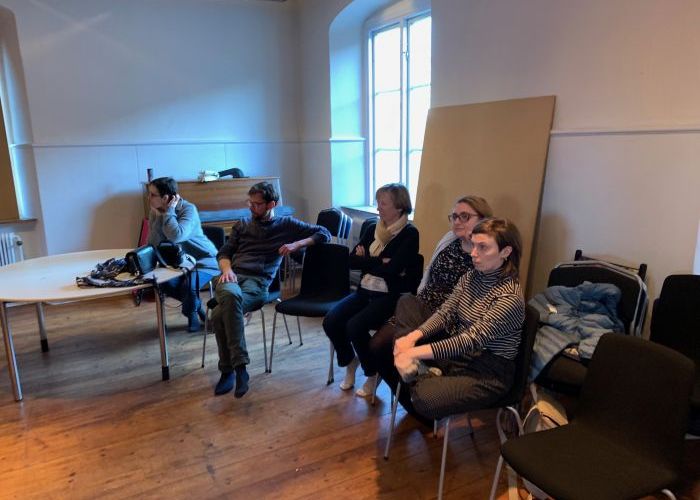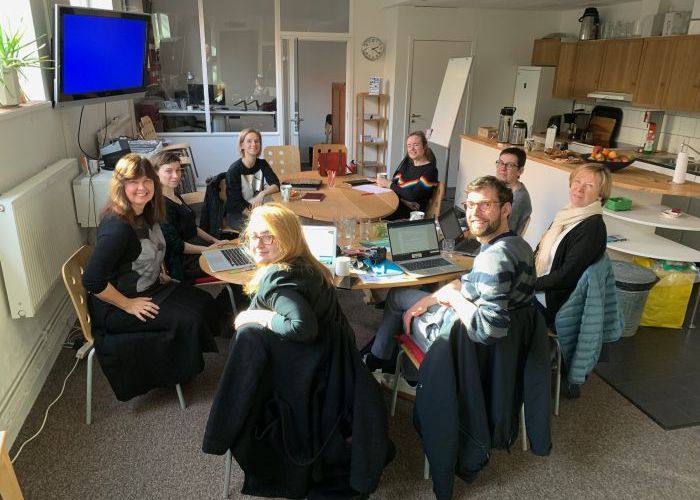C6 Sweden - a Host for Ostend
Reflections from Ostend visit to Stockholm 25-29 March 2019
Reflections from the events made by Intercult
During the last week of March 2019, Intercult had the pleasure to receive a delegation from the Ostend Public Library as part of the project I_Improve. From Intercult side we wanted to show our guest what changemaker meant to us as well as finding a definition that is as close as possible to what we want to do. We had preliminary chosen LivetBitch! as the main changemaker to observe during this week. We hade around 3 different meetings planned during the week with them to talk about how they work and understand how such a local and small organisation had been able to grow and be influencing the current state of culture in, mostly, Stockholm region.
Day 1:
For the first day of the visit we decided to go to Gnesta, a small city of 5000 inhabitant on the border between Stockholm region and the county of Sormland. This city might be small but we saw that there are many different cultural actors acting on and with the city in some ways.
As we arrived early we had time to visit the library and observe how it works, for example it is designed more as a meeting place with a citizen office for inhabitants to ask questions and get help on different daily issues.
We decided to first meet-up with a young organisation called “Vår lokal” (Our space) from seeing the organisations meeting point in downtown to their dream space we could see how these driving spirits try to put their community on the culture agenda. From an association as “vår lokal” with a 100 member to gather cultural workers with others around a lunch to dream about a cultural space for participatory arts is a big step but the visions are there and the energy is present. We talked for a while about participatory art mostly focused on the art scene. We met with Mani Dadgaranfar and Gabriel Widing. Both of them work with participatory arts in different ways. While Gabriel sees participatory arts as giving each spectactor different roles to fulfill, Mani is more into seeing participatory arts as a way for the public to make a print on the artist piece. Thoughts on how these two idea could fusion to give an end result working for Gnesta and to create Sweden’s first permanent scene for participatory arts is interesting.
Later on we visited ArtLab Gnesta where we met Signe Johannessen, chair and creative director. She gave us a tour of their premises and told about the stories forming ArtLab Gnesta as an institution. The premises have a creative aura, it is easily felt why this place was chosen to be a creative space: the history of the place being a former brewery, the graffitis from the time it was a deserted place for squatters and raves, to the german library in one of the residencies for artists which survived World War II. Signe also gave a very heartfelt insight into ArtLab Gnesta:s work and projects with a special focus on how they work to make the Saqba tomato from Syria as a swedish type of tomato or the project on the threats that art organisation engaging in political issues meet. They work on different level, towards different stakeholder and has become an established name on the swedish art scene.
Day 2:
We started the day at Intercult’s office, going through the difference between the impressions and learning between each individual on site during the visit. the discussions were interesting as each and everyone understood the visits differently, saw potential differently but also had different definitions of what a changemaker is, what a changemaker’s focus should be but also how it should work. Does it change the world around it in its approach or does it develops it surroundings?
We took the train to Södertälje and went to meet Intercult’s chosen changemaking methodology: LivetBitch! . We had a presentation of LivetBitch by Grete Havnesköld at the City hall of Södertälje where a discussion on separatism as changemaking concept started to blossom. Which somehow was not what Intercult looked at on the changemaking process, but rather the idea of having an impact on local society through cultural representation. This discussion was interesting as each of the participants had different views on what separatism meant, and here we saw also why it might not be bad for the swedish society to have separatist spaces as there are no “safe spaces” to discusses gender-related issues, the community is rather mixed altogether in most public spaces.
Before observing LivetBitch! in their studio starting their rehearsal for the upcoming show for the fall, we had a study visit to Läsfrämjarinstitutet. We met with Marlen Eskander, founder, and Beriwan Deniz, developer, in one of their reading spaces and offices. Here we could see the diversity of activities they offer kids and their parents all around books. There are reading spaces, storytelling spaces, a performance stage to have a living reading experience, but also space to cook and to draw all from the books kids read. One core idea of the methods is to measure the reading by centimeters instead of counting pages or lines read. Their prime idea is to encourage kids from diversified background to read and master the swedish language. We also watched a small video of their work where children are engaged in telling the stories they see played on the stage. The driving forces of the people working at Läsfrämjarinstitutet is really tangible and shows also why the concept is successful, the employees believe in their cause, they believe that they are making a change within society with their work. We left the premises with energy and food for thoughts on how local changemaking can be diverse and on different levels.
Later on we went over to the LivetBitch! studio to see the changemaking process in action. We had the opportunity to meet young girls in their teens learning to trust each other and developing their drama skills at the same time. One of the benefits of us being there for the girls was to learn to trust each other even in front of a public. We saw an exercise they had difficulties to perform in the beginning that Grete asked them to redo until they reached the potential she knew they had. It was an interesting experience as we could see that the girls felt more and more secure as time passed by. They tried out the outlining of the show they are writing and working on for the fall bringing to light a deeply rooted in Södertälje: “honour culture”. They try to bring light on different views on honour culture, challenging the norm of considering it only a thing of the muslim community. The play enlightens the issue of honour culture within the syrian and assyrian communities blending it with the controversy of being part of the LGBTQIA community as well as the traditionally forced marriage, the shame of not being virgin and other issues that can be considered in contradictions to the values on which the swedish society is build upon: free choice, being yourself and not having to conform to others in how to live life. After the rehearsal, we had the opportunity to discuss with the girls on their own thoughts and why they have chosen to be a part of LivetBitch!. Besides of their apparent love for performing, the girls also told about the safe space they see the organisation as.
Day 3:
On the third day we continued our meetings with the chosen changemaker, we had, in my opinion where the method used where more put into the swedish context where the need to create gender-related safe space is more and more used as a way to enlighten the work for equality and feminist issues.
Later on we had a reflection session with Avril where we discussed the different understanding of all the meetings we had so far. I believe it was very much needed to dive into different changemaking strategy. Each organisation we met so far were very much engaged in culture and society, using culture as a tool to act on their surroundings. But the main two were LivetBitch! and ArtLab Gnesta. LivetBitch! is very much local and has a neech in contrast to ArtLab Gnesta where the local work is broad but concentrated on local actions. ALG work with a greater range of project, they go directly to the need rather than using one approach to touch and change the local society. These are two interesting changemakers with two different approaches to art culture and social issues. These are two different approach, one is working openly with what comes to them while the others are more restrictive to secure the safe space for their target group.
I left this day with many different questions that I will still think about:
Is a process undemocratic because it is restrictive?
How can the organisation desiminate and engage at the same time? what is the component for success?
Should a platform for changemaker be created?
Should broader organisation enlighten local issues or is it only for local actors?
Can we engage people to crosspolinate, i.e leave their own bubble,?
How can Intercult become more relevant to Stockholm and how can Stockholm be relevant for Intercult?
Should co-cultural space take over as a new changemaking issue with an anthroposophical approach?
Haiku:
LivetBitch was here,
We saw, observed and learned,
On local actions
Day 4:
We spent the day at different libraries in Stockholm learning more about the city library of Stockholm as well as discussing from two different point of view the move of the international library.
We also went to Kista Library to have a look at how they have remodel the library to be more suitable to the new generation. The library’s changes in their inner environment has helped increased the number of visitor remarkably.
This day was focused on how public libraries adapts to the development of society as well as to the new areas of work the libraries can focus on. They have for example extensive programme on reading, storytelling and cultural events to suit every inhabitants of Stockholm.











